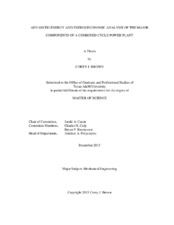| dc.description.abstract | For a power plant, or any energy conversion system, exergetic analysis methods are used to determine the irreversibilities, or exergy destruction, in the system components. Advanced exergetic analysis methods indicate that the irreversibilities within a component can be considered in two parts. The first part, which is due to irreversibilities within the component, is referred to as the endogenous exergy destruction. The second part, which is due to component interactions, is referred to as the exogenous exergy destruction. While some of the irreversibilities within an energy conversion system can be avoided by improving the performance of individual components or the system structure, due to technological and economic constraints, some are unavoidable. Newer advanced exergetic analysis methods seek to determine the realistically avoidable exergy destruction for each component in the system. Exergoeconomic methods seek to determine the cost-effectiveness of improving certain components. In this thesis, conventional and advanced methods of energy, exergy, and exergoeconomic analysis are used to evaluate the performance of the major components of a combined cycle power plant.
The conventional and advanced exergetic analyses reveal that the combustion chamber is the largest source of exergy destruction within the system, as well as the largest source of endogenous exergy destruction that can be avoided. The exergoeconomic analysis reveals that the combustion chamber is also the most cost-effective component to improve, due to its relatively low cost of capital investment and relatively high cost of exergy destruction. By reducing the air-fuel ratio, and further preheating the combustion air, 29.25 MW of exergy destruction in the combustion chamber can be avoided. This would also lead to increased performance in the expander by increasing its inlet temperature. The advanced exergy analysis also reveals that the expander is the second largest source of avoidable endogenous exergy destruction. However, the exergoeconomic analysis reveals that from a cost basis there is little room for improvement of the component. The results obtained provide useful information for the optimization of the power plant in question. | en |


